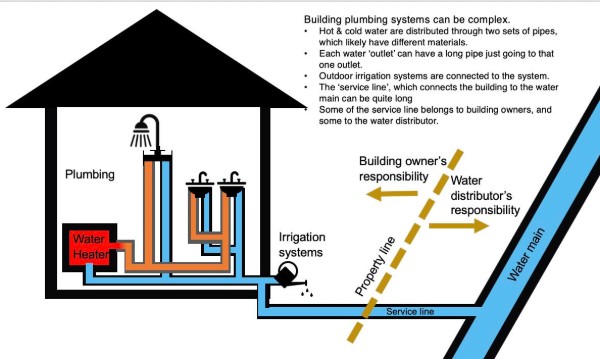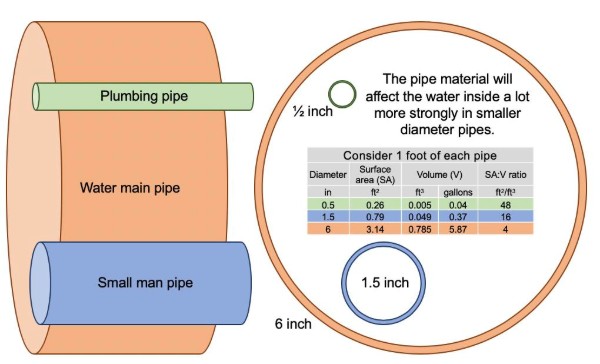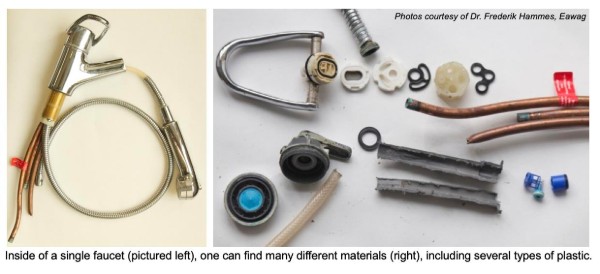Introduction to Building Plumbing
Building plumbing is complex. We know from experience that drinking water inside building plumbing acts differently than when it is in the water distribution system (the water mains outside, under the streets). On this page, we try to explain a couple of the things that make building plumbing so complex.
How does BUILDING PLUMBING differ from WATER DISTRIBUTION SYSTEMS and WELL SYSTEMS?
Many long and narrow pipes carry water from the utility WATER DISTRIBUTION SYSTEM or PRIVATE WELL to your taps. Most of the small pipes and valves belong to the building owner. Keeping these items safe and clean is the building owner’s responsibility. For buildings that receive water from WATER DISTRIBUTION SYSTEMS, some small items are the responsibility of the water distributor.
To get an idea of the complexity of your own building water system, ask yourself these questions:
- How many bathrooms do you have in your house?
- How many appliances (dishwashers, laundry machine, fridge) are connected to water?
- How many pipes and sprinklers are in your outdoor irrigation system?
- At how many water taps do you have both hot and cold water? Hot and cold water are delivered by separate pipes, so you can double your pipe lengths.
Now take a look at the schematic below. There are a variety of items that are in a building that are not in a UTILITY DISTRIBUTION SYSTEM.

Also consider that the TYPES and AMOUNT of materials (pipes, etc.) that exist in a building can make each building different from the another. The schematic below shows another way to consider plumbing even when all the houses look the same.

How different are plumbing pipe sizes from the water distribution system?
Pipe surface area to water volume (SA:V) ratio is very large in buildings. This means that with narrow pipes (pipes with a small diameter), there is a lot more pipe surface area (sides of the pipe) used to hold the same volume of water. If there is anything wrong with the pipe (for example: metals leaching out of pipes, VOCs coming out of pipes, biofilm growing on pipe walls), the pipe will have a strong impact on the water. In the WATER DISTRIBUTION SYSTEM, larger pipes are used. These larger pipes can have much less impact on what is in BUILDING DRINKING WATER QUALITY.

What are the things that make up plumbing?
Many different materials are used in building plumbing. Chemicals and bacteria will react differently to each material. Often, we think about what our pipes are made out of (copper: a metal, PVC, or PEX: different types of plastics). However, even in a copper system, many plastic materials are used, as seen in disassembled faucet below. There are many plastics in a building. For example, flexible plastics are used in gaskets, refrigerator water lines, and harder plastics are used as pipes, faucet connectors and the like. Each plastic will also have a different reaction with chemicals and bacteria. Not all plastic is created equal. AND- color has no relation to how it performs. Colorants are often added by manufacturers.

Water that sits in plumbing is called stagnation
Stagnation time is the time where water sits in plumbing when it is not moving. This time can vary based on the water use at each faucet, each is used at a different frequency. Think of a guest bathroom that is never used, or an outdoor spigot that is only used in the summer-time. These locations often have long stagnation times. As water sits in pipes for a long time, its quality changes, usually becoming worse. For example, chemicals can leach out (come out) of pipes and valves during this time. Since each tap has a different stagnation time, water quality and results may change at each tap within a building. This is what we are finding in our ongoing National Priorities plumbing study. Collecting water from one in-building location does not mean that the single water sample is representative of the whole building. This is why much thought must go into how to evaluate building drinking water safety.
